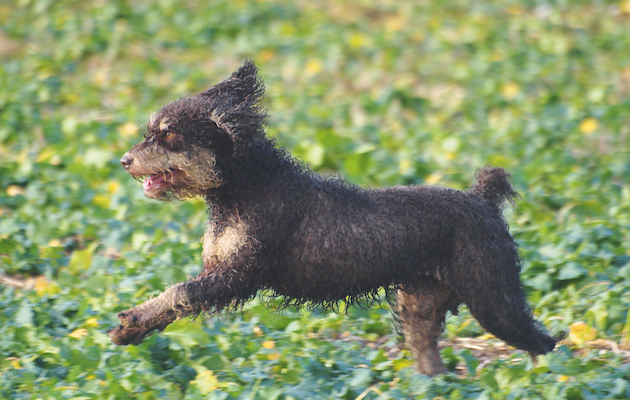You want a proper gundog and the family wants the perfect pet – and you all want something a little bit different. David Tomlinson considers the options
David Tomlinson risks offending loyal labrador enthusiasts by suggesting some alternative breeds that strike the balance of being the perfect family pet as well as being a worthy gundog.
For wild greys and redlegs, you need a worker that’s keen, thorough and won’t mind the brambles. So which is the best gundog for partridges? Alec Marsh finds out.
Once shunned in favour of the ubiquitous black, the fox-red labrador is now becoming increasingly popular, as Giles Catchpole relates.
THE PERFECT FAMILY GUNDOG
Warning: if you are a labrador enthusiast (and I suspect a majority of Fielders are), you may not want to read any further. I recently had an email from a reader who told me that his grandparents had always had black labradors, as had his parents, but now he is in a position to get his first dog he wants something different. “Let’s face it,” he wrote, “black labradors, or any colour of labradors, are so boring. They may be brilliant at bringing you your slippers, but there’s something inescapably dull and predictable about a lab. My children want a cockerpoo, but I do want a proper gundog even if it is going to be mainly a family pet. Any suggestions?”
He did add a couple of provisos. If possible, he wanted a smaller dog than a labrador, but didn’t want a cocker spaniel. “All my friends have got cockers. My shooting is mainly hedgerow pottering with a couple of friends. I get a few driven invitations but I don’t need a dog on those days as there’s always a crowd of retrievers behind the line hoovering up any bird that has the misfortune to be shot.”
As size matters, it rules out the majority of the 30-plus breeds of gundogs recognised by the Kennel Club, and all the retrievers bar one, the Nova Scotia duck tolling retriever. These compact Canadians are attractive-looking dogs that make fine pets, and they can turn their paws to anything, from gundog work to agility. The downside is their fox-like colouring – they are best worked in a Day-Glo vest to avoid any unpleasant misidentifications – and their tendency to be vocal. Labradors rarely have much to say for themselves, but tollers are the opposite.
My correspondent had ruled out having a cocker, so I’d hesitate to suggest a sprocker (cocker x English springer), as many sprockers are indistinguishable from a pure cocker. However, this is a cross that I’ve a lot of time for. For a start, it’s 100% spaniel, so can’t be accused of being a designer crossbreed, and the mixture of springer and cocker gives a touch of genetic diversity that’s no bad thing when it comes to health. I’m biased here, as I’m the owner of a three-year-old sprocker that looks just like a miniature springer though she behaves more like a cocker. Her friends, of whom she has many, all love her.
A friend has a delightful cockerdor (cocker x labrador), a remarkably successful combination but a rare one. She is smooth-coated and black, so apart from rather long ears looks very much like a small labrador; she weighs a mere 15kg, less than half the weight of a mature lab. Intriguingly, while she resembles a labrador her manner and enthusiasm for hunting are all cocker. My pal assures me that he has turned down numerous offers of cash for her. I reckon that cockerdors are a winning combination we might be hearing more of.
Almost all the continental breeds of hunters, pointers, retrievers are big, so we can rule them out. One notable exception is the Brittany. Here in Britain it used to be called the Brittany spaniel, but the word spaniel was dropped to avoid confusion with our proper spaniels; the French call it l’épagneul Bretton. (Intriguingly, épagneul translates as ‘spaniel’ but the French use our word, spaniel, when they talk about springers or cockers.) Brittanys are the most popular gundogs in France but have never caught on here. They make entertaining rough-shooting companions, for they are blisteringly fast and great at finding birds on ground where they are few in number. They are not, however, the easiest dogs to train as they tend to turn a deaf ear to the stop whistle, while not all are keen on retrieving.
I’ve recently met and been impressed by another French HPR, the braque du Bourbonnais. Though not yet recognised by the Kennel Club there’s a nucleus of these pointers in this country, mostly in working hands. What sets them apart from other continental pointers is size, for they are no bigger than an old-fashioned English springer but more lightly built and longer legged. Their appearance is distinctively pointer, as is their style of hunting. The downside of owning one is forever having to explain what breed it is.
The same is true of the Spanish water dog (SWD), an interesting animal with more than a passing resemblance to a labradoodle or cockerpoo. My first encounter with a SWD was at the Game Fair several years ago. I was chatting to a friend who, in his younger days, had been a spaniel handler of considerable repute. We were watching the gundog scurry, entertained by the usual mixture of uninterested labradors and over-enthusiastic spaniels when a woman brought a SWD into the ring. My companion was sceptical of fancy foreign breeds, so he watched with interest, expecting to be amused. He was lost for words when this compact, curly-coated dog performed a spectacularly speedy and accomplished retrieve. The Spanish water dog could well be the answer for the man who wants a gundog but whose family wants a cockerpoo, as I have suggested to my correspondent.
Save money by taking out a subscription to your favourite fieldsports magazine here





